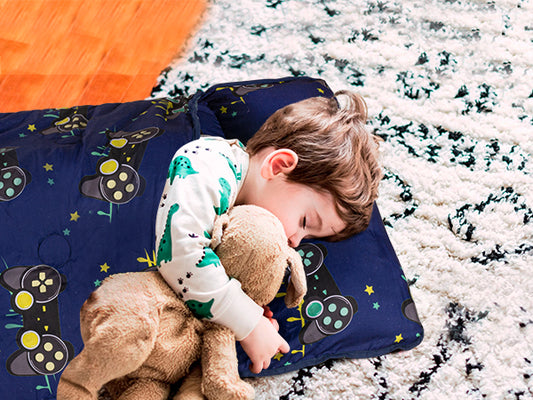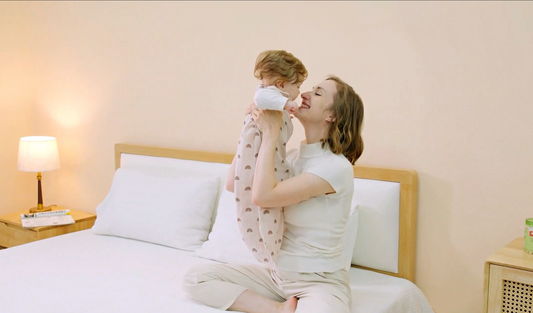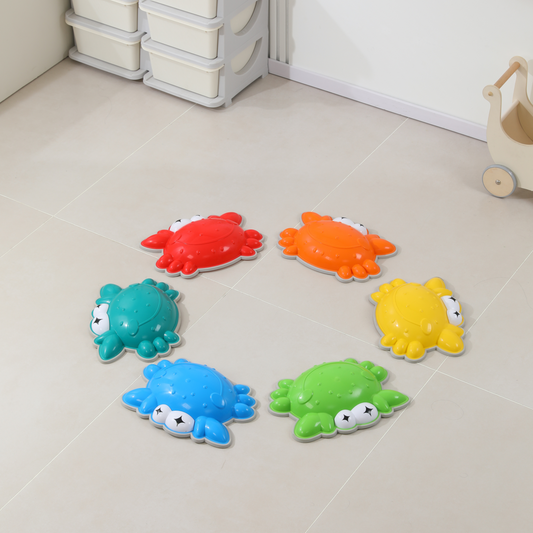Introduction to Sleep Sacks
Sleep sacks have become a popular choice for parents looking to ensure their babies and young children sleep safely and comfortably. These wearable blankets provide a snug and secure sleeping environment, reducing the risk of loose bedding that can cover a baby’s face and pose a suffocation risk. This guide will delve into the reasons why sleep sacks are essential, the appropriate age for their use, key considerations when choosing one, and an introduction to the high-quality sleep sacks offered by Primlect.
Why Children Should Sleep in a Sleep Sack
Safety and Comfort
One of the primary reasons parents opt for sleep sacks is the enhanced safety they offer. Unlike traditional blankets that can be kicked off or tangled, a sleep sack stays in place, ensuring that the baby remains warm and cozy throughout the night. This helps to maintain a consistent sleep temperature, reducing the risk of overheating or becoming too cold.
Preventing SIDS
The American Academy of Pediatrics recommends the use of sleep sacks as a safer alternative to loose blankets to reduce the risk of Sudden Infant Death Syndrome (SIDS). Sleep sacks eliminate the hazards associated with loose bedding, providing a secure and comfortable sleep environment for infants.
Ease of Use
Sleep sacks are incredibly easy to use. With their simple zip-up design, parents can quickly and effortlessly put them on or take them off their child, even during late-night diaper changes. This convenience is especially appreciated by new parents adjusting to their baby’s sleep routine.
Promoting Better Sleep
By keeping babies snug and secure, sleep sacks can help promote better and longer sleep. Babies often wake up due to the startle reflex, but the gentle pressure of a sleep sack can help soothe them back to sleep, mimicking the comforting feel of a parent’s touch.
What Age Should Children Use a Sleep Sack and When to Stop?
Newborns and Infants
Sleep sacks can be used from birth, provided they are the appropriate size for the baby. Newborns can benefit from the warmth and security of a sleep sack, which helps them transition from the womb to the outside world. For infants, sleep sacks continue to offer a safe sleeping environment as they begin to move more in their sleep.
Toddlers
As babies grow into toddlers, sleep sacks remain beneficial. They prevent toddlers from kicking off their blankets and waking up cold in the middle of the night. Many sleep sacks are designed to accommodate the growing child, with sizes that fit toddlers comfortably.
When to Stop Using a Sleep Sack
There is no set age for when to stop using a sleep sack, as it largely depends on the child’s comfort and sleeping habits. Most children transition out of sleep sacks between the ages of two and three, but some may continue to use them until they are ready to move to regular bedding. Parents should look for signs that their child is ready to stop using a sleep sack, such as attempting to unzip it or expressing a preference for regular blankets.
Factors to Consider When Choosing a Sleep Sack
Size and Fit
Choosing the right size is crucial for the safety and effectiveness of a sleep sack. It should fit snugly around the baby’s neck and arms but leave enough room for the legs to move freely. Most manufacturers provide sizing charts to help parents select the appropriate size based on their child’s weight and height.
Material and Fabric
The material of the sleep sack is another important consideration. Breathable fabrics like cotton, muslin, and bamboo are ideal as they help regulate the baby’s body temperature. Avoid synthetic materials that may cause overheating. Muslin, in particular, is known for its softness and breathability, making it a popular choice.
Seasonal Variations
Consider the climate and the season when choosing a sleep sack. Lighter, more breathable fabrics are suitable for warmer months, while heavier, insulated options are better for colder weather. Some sleep sacks come with tog ratings that indicate their warmth, helping parents choose the right one for each season.
Safety Features
Look for sleep sacks with safety features such as double zippers, which allow for easy diaper changes without fully removing the sack, and secure fastenings to prevent the baby from slipping inside. Ensuring that the sleep sack is free from small parts or loose threads that could pose a choking hazard is also essential.
Design and Aesthetics
While functionality is paramount, the design and aesthetic appeal of a sleep sack can also be important. Many brands offer a variety of colors, patterns, and designs to suit different preferences. Choosing a sleep sack that is visually appealing can make bedtime more enjoyable for both the child and the parents.
Introducing Primlect's Sleep Sacks
Multiple Sizes
Primlect offers sleep sacks in a range of sizes to accommodate growing children from newborns to toddlers. Their sizing options ensure a perfect fit at every stage of a child’s development, providing consistent comfort and security.
Variety of Designs
Primlect sleep sacks come in a variety of colors and patterns, catering to different tastes and preferences. Whether you prefer classic, neutral tones or fun, vibrant designs, Primlect has something to suit every style.
Soft Muslin Fabric
One of the standout features of Primlect sleep sacks is their use of muslin fabric. Known for its softness and breathability, muslin is gentle on a baby’s delicate skin and helps regulate body temperature, ensuring a comfortable night’s sleep.
Double Zipper Design
The double zipper design of Primlect sleep sacks offers added convenience for parents. This feature allows for quick and easy diaper changes without the need to fully remove the sleep sack, minimizing disruption to the baby’s sleep.
Safety and Quality
Primlect prioritizes safety and quality in all their products. Their sleep sacks are designed with secure fastenings and are free from any small parts that could pose a hazard. The high-quality construction ensures durability, making Primlect sleep sacks a reliable choice for parents.
FAQs
Why are sleep sacks considered safer than traditional blankets?
Sleep sacks eliminate the risk of loose bedding covering a baby’s face, reducing the risk of suffocation and SIDS.
Can newborns use sleep sacks?
Yes, sleep sacks are suitable for newborns as long as they fit properly and are designed for their size and weight.
What material is best for sleep sacks?
Breathable fabrics like cotton, muslin, and bamboo are ideal for sleep sacks as they help regulate body temperature.
How do I know when my child is ready to stop using a sleep sack?
Children typically transition out of sleep sacks between ages two and three. Look for signs like unzipping the sack or preferring regular blankets.
Are Primlect sleep sacks safe?
Yes, Primlect sleep sacks are designed with safety in mind, featuring secure fastenings and high-quality materials free from hazards.
What are the benefits of a double zipper design in sleep sacks?
A double zipper allows for easy diaper changes without fully removing the sleep sack, minimizing disruption to the baby’s sleep.
Sleep sacks are an essential part of creating a safe and comfortable sleep environment for babies and young children. They offer numerous benefits, including enhanced safety, comfort, and better sleep quality. By considering factors such as size, material, and safety features, parents can choose the perfect sleep sack for their child’s needs. Primlect’s sleep sacks stand out with their multiple sizes, soft muslin fabric, and convenient double zipper design, making them an excellent choice for parents seeking quality and reliability. Investing in a good sleep sack can significantly improve your child’s sleep experience and provide peace of mind for parents.





